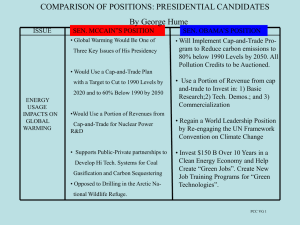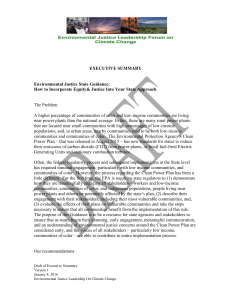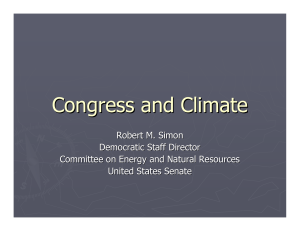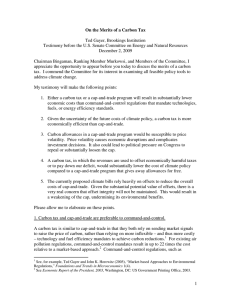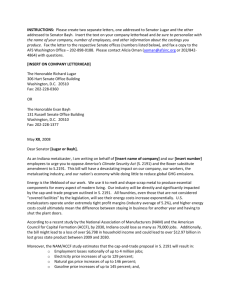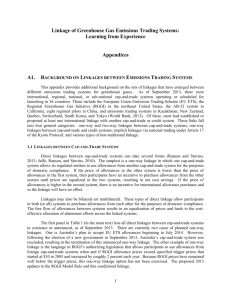DATE: July 31, 2013 TO: Housing and Land Use Committee and
advertisement
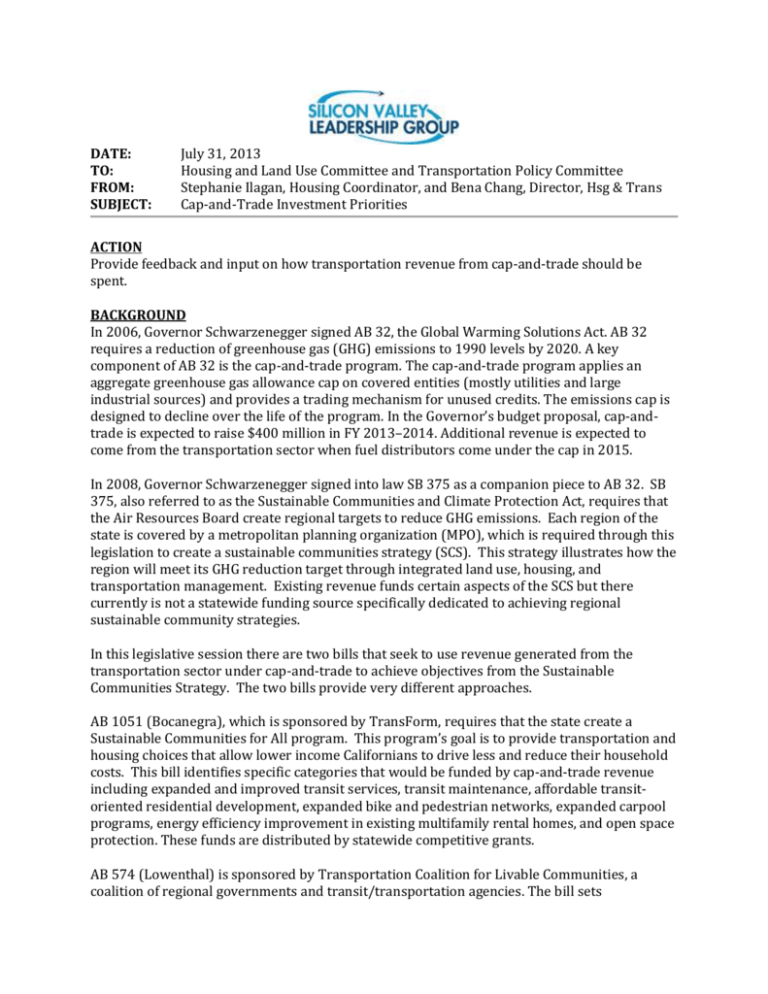
DATE: TO: FROM: SUBJECT: July 31, 2013 Housing and Land Use Committee and Transportation Policy Committee Stephanie Ilagan, Housing Coordinator, and Bena Chang, Director, Hsg & Trans Cap-and-Trade Investment Priorities ACTION Provide feedback and input on how transportation revenue from cap-and-trade should be spent. BACKGROUND In 2006, Governor Schwarzenegger signed AB 32, the Global Warming Solutions Act. AB 32 requires a reduction of greenhouse gas (GHG) emissions to 1990 levels by 2020. A key component of AB 32 is the cap-and-trade program. The cap-and-trade program applies an aggregate greenhouse gas allowance cap on covered entities (mostly utilities and large industrial sources) and provides a trading mechanism for unused credits. The emissions cap is designed to decline over the life of the program. In the Governor’s budget proposal, cap-andtrade is expected to raise $400 million in FY 2013–2014. Additional revenue is expected to come from the transportation sector when fuel distributors come under the cap in 2015. In 2008, Governor Schwarzenegger signed into law SB 375 as a companion piece to AB 32. SB 375, also referred to as the Sustainable Communities and Climate Protection Act, requires that the Air Resources Board create regional targets to reduce GHG emissions. Each region of the state is covered by a metropolitan planning organization (MPO), which is required through this legislation to create a sustainable communities strategy (SCS). This strategy illustrates how the region will meet its GHG reduction target through integrated land use, housing, and transportation management. Existing revenue funds certain aspects of the SCS but there currently is not a statewide funding source specifically dedicated to achieving regional sustainable community strategies. In this legislative session there are two bills that seek to use revenue generated from the transportation sector under cap-and-trade to achieve objectives from the Sustainable Communities Strategy. The two bills provide very different approaches. AB 1051 (Bocanegra), which is sponsored by TransForm, requires that the state create a Sustainable Communities for All program. This program’s goal is to provide transportation and housing choices that allow lower income Californians to drive less and reduce their household costs. This bill identifies specific categories that would be funded by cap-and-trade revenue including expanded and improved transit services, transit maintenance, affordable transitoriented residential development, expanded bike and pedestrian networks, expanded carpool programs, energy efficiency improvement in existing multifamily rental homes, and open space protection. These funds are distributed by statewide competitive grants. AB 574 (Lowenthal) is sponsored by Transportation Coalition for Livable Communities, a coalition of regional governments and transit/transportation agencies. The bill sets performance goals and allows regions to figure out how to spend funds to best achieve the goals and their Sustainable Communities Strategies. Transportation agencies historically have opposed using transportation funds for non-transportation purposes like affordable housing. Unlike AB 1054, AB 574 does not include a set-aside for housing. In the Bay Area, the Metropolitan Transportation Commission (MTC) and the Association for Bay Area Governments (ABAG) recently adopted the Bay Area’s SCS, known as Plan Bay Area. Plan Bay Area includes a reserve account specifically for projected cap-and-trade revenues to be used for transit-oriented affordable housing, transit operating and capital rehabilitation and replacement, and for local street and road rehabilitation.1 Plan Bay Area does not assign revenue to any of these eligible categories. ANALYSIS Last year, the Leadership Group adopted a broad set of principles on cap-and-trade expenditures. The full list of AB 32 Cap-and Trade Investment Opportunities document is attached. The principles focused on Clean and Efficient Energy and Next-Generation LowCarbon Transportation, Natural Resources Management, and Sustainable Infrastructure Development. Specifically on transportation investments, we support transportation efficiency measures, land use incentives and improved transportation options. Staff seeks additional input on the priorities among the various principles. Specifically, is this organization comfortable with spending revenue raised from the transportation sector on transit-oriented and/or affordable housing. To help facilitate the discussion, staff put together a table summary cost for development and CO2 reductions per year for various projects that could be funded under cap-and-trade. Tons of CO2 reduced per year Cost People Cost/ton of CO2 reduced annually Affordable transitoriented Housing 2 3 per unit $356,583/unit 3 per unit $118,861 Bus Rapid Transit (El Camino)3 9,188 total $13 million/mile 33,000 daily $23,487 BART extension to Silicon Valley 28,947 total4 $368,750,000/mile5 794,894 daily6 $203,820 Bike Lanes in SF 5,300 total7 $529,411/mile8 11,640 daily in San Jose9 $3,396 1 Average trip of 3.3 miles http://onebayarea.org/pdf/final_supplemental_reports/FINAL_PBA_Financial_Assumptions.pdf Michael Lane, NonProfit Housing 3 http://www.vta.org/brt/el_camino.html 4 http://www.bart.gov/images/bluesky/GreenSheet.pdf 5 http://www.walkinginfo.org/engineering/roadway-bicycle.cfm 6 http://www.vta.org/bart/images/Environmental/draft_seir/4_2.pdf 7 http://www.spur.org/publications/library/report/critical_cooling/option21 8 http://www.spur.org/publications/library/report/critical_cooling/option21 9 http://sf.streetsblog.org/2012/08/21/san-jose-sets-out-to-build-the-bay-areas-most-bike-friendly-downtown/ 2 High-Speed Rail 10 100,000 total $1,375,000/mile 87,677 daily $11,000 Questions for the Housing and Land Use and Transportation Policy Committees to consider: 1. Should revenue from cap-and-trade be allocated through statewide competitive grants or to individual regions? 2. Should transportation revenue from cap-and-trade be invested in affordable housing? 10 http://www.hsr.ca.gov/docs/about/legislative_affairs/HSR_Reducing_CA_GHG_Emissions_2013.pdf
